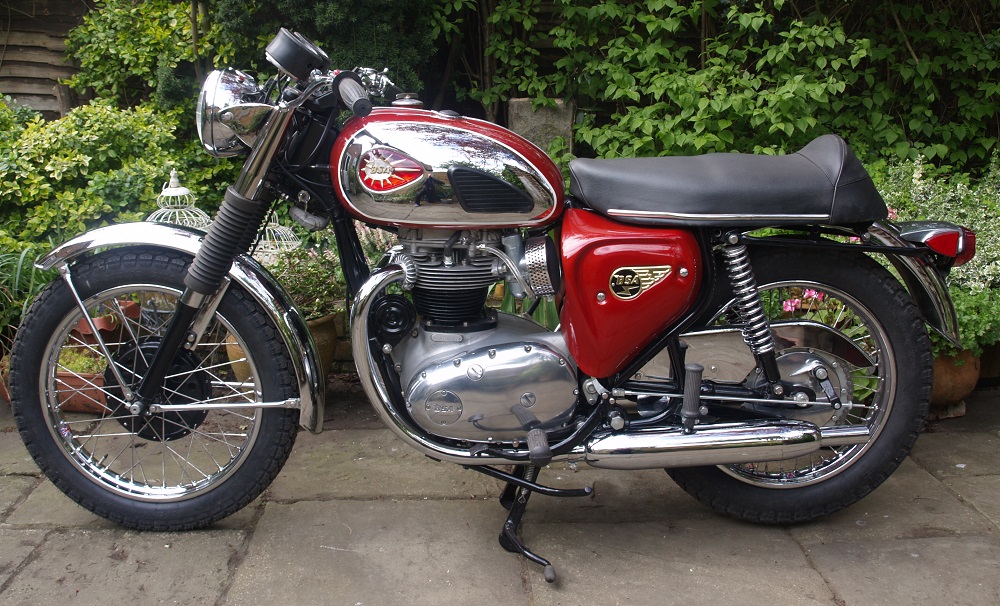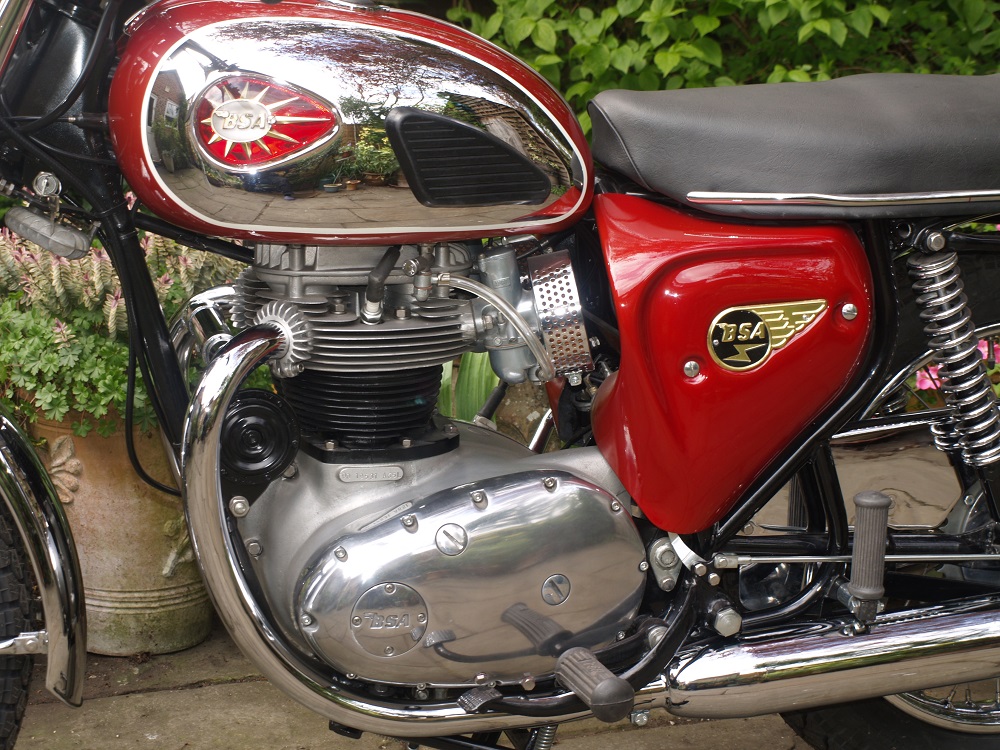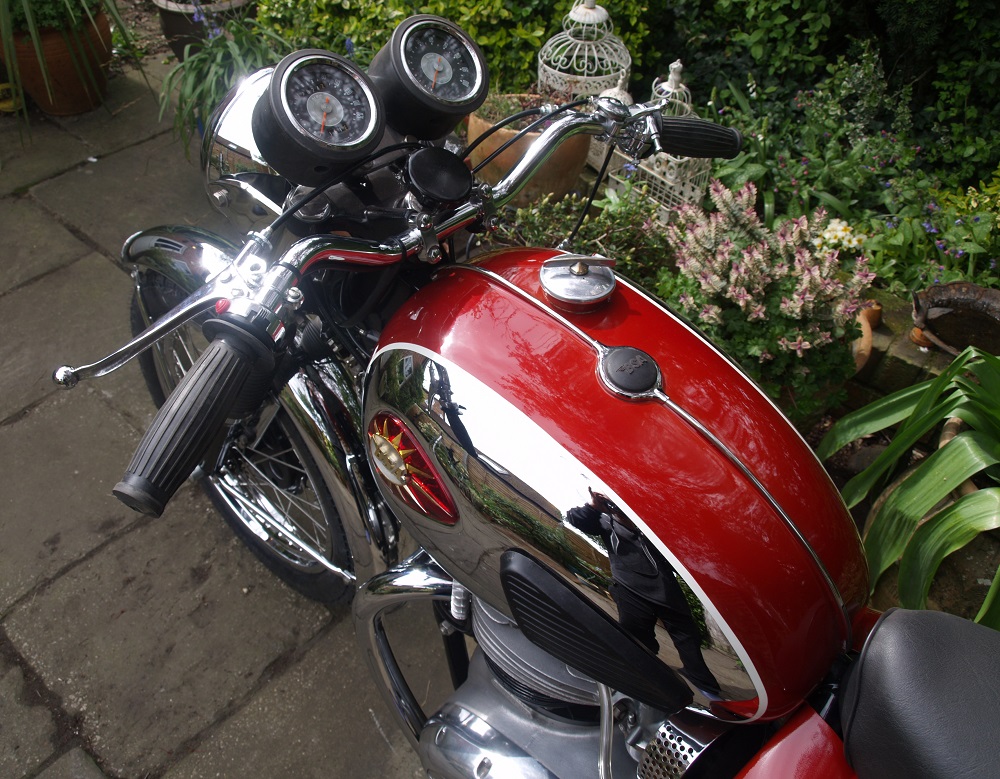The BSA A65 650 cc twin cylinder motorcycle, along with its 500 cc A50 smaller twin, were introduced to the public in January 1962. They were intended to replace the 500 cc A7 and 650 cc A10 twins that had been in production since 1946 and 1949, respectively. These two earlier models, like most motorcycles of that era, used a separate gearbox from the engine that is now referred to as being of pre-unit construction. Triumph Motorcycles introduced a unit construction twin (model 3TA) with combined engine and gearbox in 1957. However, it took BSA until 1962 to introduce the unit construction A50 and A65 with the pre-unit A7 and A10 continuing until 1963.
The new unit construction engines had very clean lines but were slightly bulbous in appearance which then gave the A50/A65 a somewhat podgy look. The bikes used an all welded, full duplex frame with twin front down tubes which then curved around the bottom of the engine before re-joining the single top tube just in front of the seat. The engine was mounted in the frame via long bolts at the front and underneath, and used a lug and engine plates at the rear. A head steady was bolted from the front of the cylinder head to the front of the frame just below the steering head.
The A65 was originally named the Star and was produced in this form between 1962-64. It was fitted with a four gallon petrol tank with chrome panels and pear shaped BSA badges. It used painted, valanced mudguards with 18″ wheels along with a headlight nacelle covering the top of the fork legs. The headlight shell housed the speedometer together with the ignition and lighting switches. A central oil tank was fitted with a tool box mounted behind it on the right-hand side of the bike. The battery was housed on a carrier mounted to the left of the oil tank and glass fibre side covers were added to either side under the seat. The A65 Star engine was fitted with a single AMAL Monobloc carburettor and the bike made use of 6V electrics.
The next model produced in 1964 was the A65 Rocket. This differed from the A65 Star in having a higher compression ratio engine (9.0:1) and a sportier camshaft but was still fitted with a single carburettor. It made use of a separate chromed headlight shell with gaiters used to cover the front fork springs, and included both a speedometer and rev counter mounted on a bracket above the top steering yoke. The A65R was fitted with chrome plated mudguards but was otherwise similar to the A65 Star.
In the same year, three separate A65 models were introduced for the US market: these were the Thunderbolt Rocket, Lightning Rocket and Spitfire Hornet. The first used the A65R engine and was similar to the A65R except for small changes to suit the US market including a 2 gallon petrol tank option with round badges. The A65L/R was fitted with twin carburettors . The A65 S/H was basically an off-road version of the A65L/R and used a 2 gallon fibre glass petrol tank with transfer badges
For 1965, both the A65L/R and A65S/H remained but the A65T/R disappeared as the US riders preferred the twin carb model. For the home market, there were two A65 models: the Lightning and the Lightning Clubman, both with twin carbs, siamesed exhaust systems and 19″ wheels with offset hubs. The A65LC was intended for competition use and had close ratio gears, rear sets, low handlebars and humped seats.
This model range was somewhat excessive and so in 1966 the A65 model range was simplified to leave just four models: the Thunderbolt, the Lightning, the Hornet and the Spitfire, the latter in MK II form. One of the main changes to the engine for these models was the introduction of a lipped roller bearing in place of the earlier drive side ball bearing for the crankshaft. This caused significant problems as described below and damaged the reputation of the higher performance BSA A65’s.
In 1966, all models were fitted with the modified frame introduced in the previous years for the US models. Instead of a continuous top tube under the seat, the new frame was open at the rear and used a different method for supporting the rear mudguard. It also included a different battery carrier suspended from above via rubber bushes and the swinging arm pivot no longer incorporated a cross-shaft for the rear brake rod which was moved to the left-hand side of the bike. Other changes included the use of two-way damping in the front forks and the use of gaiters and a separate headlight shell throughout the model range. The headlight now housed just the lighting switch with the ignition switch having been move to below the headstock. All models acquired 12V electrics.
The 1966 A65T was fitted with a single carb, a 9.0:1 compression ratio engine and used a 3-gallon petrol tank with pear shaped badges and had a flat dual seat. The A65L was fitted with a humped dual seat and the A65SS, which was intended for production racing, was fitted with a 10.5:1 and twin AMAL GP carbs. The A65SS used either a 5-gallon for 2-gallon glass fibre petrol tank. For off-road, there was still the A65 Hornet.
In 1967, there was only a few changes in the A65 model range with all four models continuing. For the engine, the rocker cover was changed to a finned design and a round cover was introduced to the chaincase to facilitate using a strobe light for timing. All models now used a humped dual seat and the rear wheel was changed to 4.00 x 18 inch tyres.
In 1968, the Hornet became the Firebird Scrambler. The A65L, A65S and A65FS all acquired an 8″ full width hub for the front wheel with twin leading shoe brake. All three models and the A65T changed to front forks with splits ends which clamped to the front wheel spindle. All the models were now fitted with AMAL Concentric carburettors.
In 1969, there were only two A65 models left with the Spitfire having been replaced by the Rocket 3 triple. Both the A65T and A65L acquired balance pipes just in front of the cylinders. Very little changed for 1970. One of the main changes to the engine was the introduction of a three-ball clutch lift mechanism similar to that used in Triumphs.
In 1971, the major change was the introduction of the Oil-in-Frame (OIF) design instigated by BSA’s notorious Umberslade Hall design centre. This frame was widely regarded as a solution to a problem that did not exist and resulted in a frame with excessive seat height that did little to suit shorter riders. In addition to the new frame, the A65 models were fitted with alloy conical wheel hubs and cast alloy slimline forks with a new 2-way damping system. Three model remained: the A65T, A65L and A65FS.
The engine was largely unchanged from 1970. A conventional chrome plated rear mudguard was fitted supported by a stay that incorporated the grab rail for the pillion passenger. A chrome plated, close fitting mudguard was fitted to the front wheel supported by rubber mounted stays which were not very strong. Indicators were fitted on stalks to the road going models with Lucas switch units fitted to the clutch and front brake lever mounting clamps. A pan shaped headlight was fitted which incorporated the light switch and warning lights.
A more angular petrol tank was fitted to the 1971 models. Since the engine oil was now carried in the frame, the space under the seat in front of the rear mudguard was used only to accommodate the battery and the air filter box. The plastic air filter box occupied the full width of the frame in front of the battery rubber mounted carrier. The filter box incorporated two separate filters on either side and was made up of four mouldings which were slightly different depending on whether one or two carburettors were fitted to the engine. The seat now hinged to the right in order to provide access to the battery mounted behind the air box. The finish for all three models was similar with the frame painted in Dove Grey which was notoriously difficult to keep clean and was therefore not popular.
1972 was the last year the A65 twins were produced with the BSA Group going out of business in the following year. For 1972, the A65FS was dropped but a larger capacity A70L was produced for the US market. Otherwise, the models were largely unchanged from the previous year.
I have been brought up on both Triumph and BSA motorcycles and the A65 definitely epitomes the difference in engineering and design philosophies between the two companies. In my view, Triumph produced the best designed and engineered twin unit construction motorcycles at the time. In contrast, BSA were very conservative and a little dull in their approach to the engineering design of the A65 and, as a result, it failed to make the same impact on the buying public as their Triumph stable mates .
Engine Design
The pre-unit BSA twins used a magneto/dynamo combination for their electrics and the drive gears for these gave the A7 and A10 their distinctive 3-lobe timing cover shape. In contrast, the new unit construction twins used alternator electrics that greatly simplified the layout of the timing gears. The net result was a very streamlined design for both the right-hand and left-hand sides of the engine. The term ‘power egg’ was coined to describe the resulting design.
The cylinder design of the A50/A65 was very similar to that of the A7/A10 with a single cam shaft and push rod tunnel cast into the rear together with guide channels for the four tappets. Where the A50/A65 differed greatly from the A7/A10 was in the design of the cylinder head. The latter were very similar to previous BSA models and used a separate rocker box bolted down on to the cylinder head. In contrast, the cylinder head casting for the A50/A65 incorporated lugs to support the rocker spindles and was a much more robust construction than for the A7/A10. The downside was that the top of the cylinder head and rockers was then enclosed by a not very attractive large shallow cover.
From an engineering point of view, the clean simple lines of the A50/A65 engines was a significant achievement compared with the more complex appearance of other pre-unit and unit twin engines. Unfortunately, as demonstrated by the Triumph twin engines, it was sometimes this complex appearance that appealed to people’s aesthetic tastes. What BSA managed to achieve with the A50 and A65 engines was a big lump of an engine with very little aesthetic appeal to most people which was, unfortunately, compounded by BSA taking a similar approach to the rest of the bike. It was a portly engine that resulted in a portly looking bike!
Had the new A50/A65 engines been a robust design then their slightly unappealing lumpiness might have been less of an issue. Unfortunately, these engines suffered from a number of fundamental engineering weaknesses stemming largely from the use of a plain timing side bush for the crankshaft through which oil was pumped to the big-end bearings. When new, the oil supply worked reasonably well but, as the bush wore, the oil supply pressure dropped and the left-hand big-end in particular suffered the most from lack of oil, sometimes resulting in engine failure. For the unit singles, this problem was solved eventually by using a timing side ball bearing and an end-fed crankshaft for the big-end oil supply.
The use of the timing side bush necessitated the use of a drive side caged ball bearing. This bearing was able to take the axial forces generated by the crankshaft and, with the use of shims, controlled the end play of the shaft. However, a ball bearing is only designed to take limited radial forces and, as higher and higher powered A65 engines were developed, the ball bearing was no longer able to cope. In 1966 this was changed to a lipped roller bearing but, because this type of bearing cannot take large axial loads, it eventually allowed the crankshaft to wander sideways chewing up the shims and thrust washers.
BSA never solved these problems with the A50 and A65 which retained the timing side bush throughout their lifetime. It took the likes of SRM to provide a proper solution to the problem with their end-fed crankshaft conversion and replacement of the timing side bush with a combined needle and ball bearing which positively located the axial position of the crankshaft. Why BSA did not do this definitely reflects badly on the engineering priorities of the company during the 1960’s and early 1970’s, especially as the end fed crankshaft solution was applied to their unit singles from 1967 onwards.
My A65 Lightning Restoration
I acquired my A65L about 10 years ago in very poor condition – it is essentially a 1967 model but with the earlier style of side panels fitted. I made an initial attempt at restoration when I got the bike but then put the project to one side in favour of other restoration projects. At that time, I rebuilt the engine which involved replacing all the bearings and seals, re-boring the cylinders and replacing the valves and springs. It also involved replacing the clutch friction plates and springs.





During the earlier phase of restoration, I also had the frame powder coated in gloss black and replaced the steering head and swinging arm bearings. The front fork stanchions, seals and bushes were replaced and I rebuilt the two wheels using chrome rims and stainless steel spokes. Everything was assembled and the engine re-fitted and a new headlight and chrome plated mudguards and stays were fitted.
When I re-started the restoration in 2019, the two main outstanding tasks were the installation of the electrical system and the painting of the petrol tank and side panels. The bike was completely missing the wiring harness and most of the electrical components had to be bought new from the usual main suppliers. The main challenge was to acquire the Zener diode and its heat sink. Unfortunately, the original Lucas Zener diodes are no longer manufactured and, in the end, I had to acquire a good used working example from the US where I also acquired a used heat sink.
I then constructed the wiring harness from scratch using the correct colour coded cables. This was largely straightforward but it is always wise to lay out the wiring approximately before adding any sheathing. One of the main challenges was to properly mount the ignition coils on the frame and to mount the remote contact breaker capacitors. For the latter, I had to acquire the proper mounting bracket from the US together with its rubber shroud.
The other main task was the spray painting. Although there were only three items to paint, this was made much more difficult because the bike was originally painted in BSA Flamboyant Red. Unfortunately, this is a Candy paint which means that a red lacquer has to be applied on top of a metallic base coat and then finished with a clear coat. The main difficulty is that this is a relatively complex process with very little room for error with the lacquer having to be applied in a consistent multi-layer thickness – if not, the difference in thickness will show up as a variation in intensity of the final red colour. The tank was naturally much more difficult to paint than the side panels especially as it needed to include the painting of the white line around the chrome panels. It is also always a challenge to mask off the proper shape of the chrome panels with the approach I adopted being to try to achieve a fairly constant width of the painted area on top of the tank when viewed from the riding position. Despite the effort required on my part, the final result was very satisfying although I am definitely going to avoid any more Candy painting in the future!
The remaining task needed to complete the restoration was to replace all the control cables and to fit a brand new exhaust system. It has taken me 10 years to finish this project but I am very pleased with the result.
BSA A65L Specifications (non-OIF)
- Engine: Twin cylinder, 360 deg, OHV
- Starting: Kickstart only
- Capacity: 654 cc
- Bore/Stroke: 75 x 74 mm
- Compression Ratio: 9.1:1
- Max Power: 52 bhp
- Carburettor: 2 x Amal 389 Monobloc carburettors (1966-67 )
- Carburettor: 2 x Amal 930 Concentric carburettors (1968 – 72)
- Cooling: Air cooled
- Lubrication: Dry sump
- Ignition: Coil and contact breaker points
- Transmission: 4 speed foot shift
- Final Drive: Chain
- Front Suspension: Coil spring and hydraulically damped
- Rear Suspension: Coil spring and hydraulically damped
- Front Brake: 8 inch offset single leading shoe 1966-67
- Front Brake: 8 inch twin leading shoe 1968-72
- Rear Brake: 7 inch drum single leading shoe
- Frame: Half duplex cradle
- Wheel Base 56 inch
- Seat Height: 32 inch
- Front Tyre 3.25 x 19 inch
- Rear Tyre: 3.50x 19inch (1965)
- Rear Tyre: 4.00 x 18 inch (1966-72)
- Ground Clearance: 8 inch
- Dry Weight: 395 lb
- Fuel Tank: 4 gallons
- Oil Tank: 5 pints
BSA A65 Parts Suppliers
Most A65 spare parts are relatively easy to get hold of with many good suppliers easily found on the internet. Two of the larger suppliers of BSA parts are Burton Bike Bits and Dragonfly Motorcycles.
24,654 total views, 8 views today

